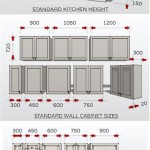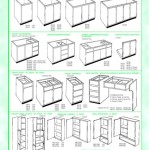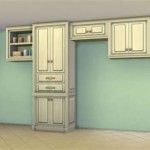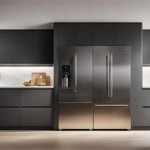Kitchen Sink Cupboard Storage Ideas
The cupboard beneath the kitchen sink often becomes a repository for cleaning supplies, dish soap, and various odds and ends. However, its potential for organized storage is frequently overlooked. Implementing effective storage solutions in this space can significantly improve kitchen efficiency, reduce clutter, and make essential items easily accessible. This article explores various strategies for maximizing storage within the under-sink cupboard, focusing on practical and adaptable ideas suitable for diverse kitchen configurations.
Evaluating the Existing Space
Prior to implementing any storage solutions, a thorough assessment of the existing space is crucial. This involves a complete decluttering of the cupboard, removing all items and evaluating their necessity. Discarding expired or unused products is the first step toward creating a more organized environment. Next, measure the internal dimensions of the cupboard, including height, width, and depth. Note any obstructions, such as plumbing pipes or garbage disposals, as these will influence the selection and placement of storage solutions.
Consider the frequency with which different items are used. Regularly used items, such as dish soap and cleaning sprays, should be placed in easily accessible locations. Less frequently used items, such as spare sponges or cleaning cloths, can be stored in less accessible areas. Finally, assess the current lighting conditions within the cupboard. Poor lighting can hinder visibility and make it difficult to locate items. Adding a battery-operated LED light can significantly improve visibility.
Utilizing Vertical Space with Shelving
One of the most effective ways to maximize storage in the under-sink cupboard is to utilize vertical space by installing shelving. Shelving allows for the separation and organization of items, preventing them from becoming a jumbled mess. Adjustable shelves are particularly useful, as they can be customized to accommodate items of varying heights. Consider using wire shelving, which allows for airflow and prevents moisture buildup. Alternatively, solid shelves made of wood or plastic can provide a more stable surface for heavier items.
Tension rod shelves offer a simple and inexpensive solution for creating additional storage. These rods can be easily installed and adjusted without the need for tools or drilling. They are particularly useful for storing spray bottles or hanging cleaning cloths. Another option is to install pull-out shelves, which allow for easy access to items stored at the back of the cupboard. These shelves slide out smoothly, making it easier to see and retrieve items without having to reach deep into the cupboard.
Corner shelves can effectively utilize the often-wasted space in the corners of the cupboard. These shelves can be either fixed or rotating, depending on the available space and personal preference. Rotating corner shelves, also known as lazy Susans, provide easy access to items stored in the corners. Another option is to install a tiered shelving unit, which creates multiple levels of storage within a small footprint. This type of unit is particularly useful for storing small items, such as sponges, scrub brushes, and dish soap refills.
Implementing Door Storage Solutions
The inside of the under-sink cupboard door offers valuable storage space that is often overlooked. Various door storage solutions can be implemented to maximize the use of this space. Over-the-door organizers, such as hanging racks or baskets, are easy to install and provide convenient storage for commonly used items. These organizers are particularly useful for storing spray bottles, cleaning cloths, and sponges.
Another option is to install small shelves or caddies on the door. These can be used to store dish soap, hand soap, or other small items. Adhesive hooks or clips can also be used to hang cleaning tools, such as dusters or spray bottles. Be sure to choose hooks or clips that are strong enough to support the weight of the items being stored. Furthermore, consider the thickness of the door and the depth of the cupboard when selecting door storage solutions. Ensure that the items stored on the door do not interfere with the closing of the cupboard.
Using a magnetic strip attached to the inside of the door can provide a convenient storage solution for small metal items, such as scrub brushes or steel wool. This helps keep these items organized and easily accessible. Small containers or bins can be attached to the door using adhesive strips or screws to store sponges, cleaning cloths, or other small items. Ensure that the containers are lightweight and securely attached to prevent them from falling off.
Organizing with Bins, Baskets, and Containers
Using bins, baskets, and containers is essential for organizing the contents of the under-sink cupboard. These storage solutions help to categorize and contain items, preventing them from becoming disorganized and difficult to find. Clear plastic bins are particularly useful, as they allow you to easily see the contents without having to remove the bin from the cupboard. Labeling the bins with their contents further enhances organization and accessibility.
Baskets made of wire, wicker, or fabric can also be used to store items. These baskets provide a more decorative storage solution, while still maintaining organization. Choose baskets that are appropriately sized for the items being stored and that fit comfortably within the cupboard. Stackable containers are another useful storage solution, as they allow you to maximize vertical space. These containers are particularly useful for storing items that are not frequently used.
Consider using drawer organizers to compartmentalize the contents of drawers within the cupboard. These organizers help to keep items separated and prevent them from rolling around. Silicone mats can be placed on the bottom of shelves or drawers to prevent items from sliding. This is particularly useful for storing bottles or containers that may be prone to tipping over. A turntable or lazy Susan can be used to organize items in the corners of the cupboard, making them easily accessible.
Managing Plumbing and Obstructions
Plumbing pipes and garbage disposals often present challenges when organizing the under-sink cupboard. It is important to work around these obstructions and utilize the available space effectively. U-shaped shelves or organizers are specifically designed to fit around plumbing pipes, allowing you to maximize storage without interfering with the plumbing. These shelves provide a stable surface for storing items while accommodating the pipes.
Another option is to use flexible storage containers that can be easily maneuvered around pipes. These containers can be bent or shaped to fit into tight spaces, allowing you to utilize every inch of available space. Consider using a small stool or platform to raise items above the level of the pipes. This creates additional storage space beneath the elevated items. Be sure to secure the stool or platform to prevent it from tipping over.
If a garbage disposal takes up a significant amount of space, consider storing items around the disposal rather than directly beneath it. Use bins or baskets to contain items and prevent them from coming into contact with the disposal. Regularly inspect the plumbing and garbage disposal for leaks or damage. Addressing these issues promptly can prevent water damage and maintain the integrity of the cupboard. Consider installing a water leak detector under the sink to provide early warning of potential leaks.
Maintaining a Clean and Organized Space
Once the under-sink cupboard has been organized, it is important to maintain the organization through regular cleaning and decluttering. Regularly remove all items from the cupboard and wipe down the shelves and surfaces. This helps to prevent the buildup of dirt and grime. Check for leaks or spills and clean them up immediately. Water damage can lead to mold growth and damage to the cupboard.
Periodically review the contents of the cupboard and discard any expired or unused items. This helps to prevent clutter and maintain a more organized space. Return items to their designated storage locations after use. This prevents items from becoming misplaced and helps to maintain organization. Consider using a checklist or inventory to track the contents of the cupboard. This can help you to identify items that need to be replenished or discarded.
Establish a regular cleaning schedule for the under-sink cupboard. This could involve a quick wipe-down on a weekly basis and a more thorough cleaning on a monthly or quarterly basis. By maintaining a clean and organized space, you can ensure that the under-sink cupboard remains a functional and efficient storage area in your kitchen.

17 Ways To Organise Your Under Sink Kitchen Cabinet Houzz Ie

Under Kitchen Sink Cabinet Storage Ideas On Sutton Place

Inexpensive Storage Ideas To Make The Most Of A Kitchen Sink Cabinet Diy S Organization
:max_bytes(150000):strip_icc()/Under-the-Sink-161-423fe5a88719431790293be714e88be1.jpeg?strip=all)
9 Genius Under Sink Storage Ideas

Under Sink Howards Storage World Blog Organised Inspired

Kitchen Sink Cabinet Organization Ideas And Solutions Modern Glam

18 Genius Under The Sink Storage Ideas And Organizers

25 Brilliant Under Sink Storage Ideas For Kitchen Organizers Homemydesign

Under Kitchen Sink Organization Ideas Clean And Scentsible

30 Ways To Declutter Your Kitchen Home Organization Diy
Related Posts








